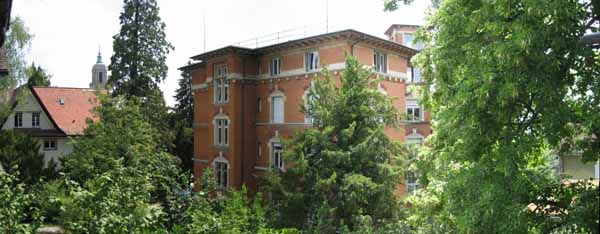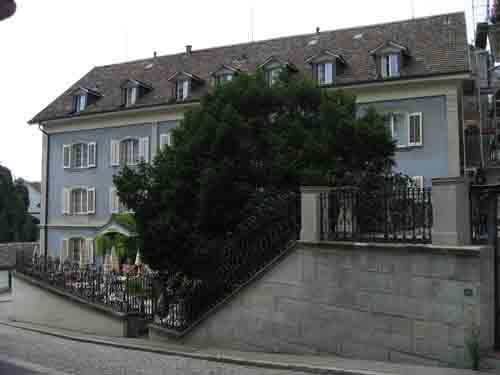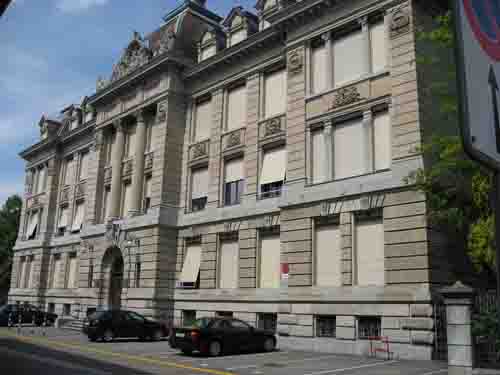
First Visit to the E.T.H.

Visiting the E.T.H. began for me in the summer of 1968. The prehistory for my first visit traces back to 1961, when I was still a student at Cambridge. Having become interested in the work of Kurt Symanzik, I learned that he and many other interesting persons would give lectures in a summer school in Hercegnovi, organized by Bruno Jackic from Belgrade. There was a great demand to attend the school by much more senior students, but ultimately I was able to go as an “observer.” There I became friendly with another student, Klaus Hepp from the E.T.H.; we met again in Paris (1963) and in Princeton (1964).
In the summer of 1967 I moved from Princeton and Stanford to Harvard, becoming an assistant professor. Shortly afterward, Res Jost and Klaus Hepp invited me to spend the following summer in Zürich. Eventually I appeared in the catalog as “Gastprofessor,” and gave a course entitled Constructive Quantum Field Theory. The experiences that unfolded over those ten weeks in Zürich shaped much of my scientific life, and began many other trips to my favorite place to visit, the E.T.H.
The Seminar für Theoretische Physik occupied the top two floors of Hochstrasse 60, the red brick building centered in the photo above. On the lower floors were members of the Swiss Institute for Nuclear Research. Peeking over the house to the left, you can see the steeple of the Kirche Fluntern which dominates the neighborhood. Continuing along the street you come to the tram line number 6, which climbs from the Hauptbahnhof up the Zürichberg. I generally got off the tram at the Voltastrasse stop and walked up the steep Hädliweg to Hochstrasse. In later years I more regularly continued on the tram to the next stop where one can access Hochstrasse and walk along the ridge of the hill.
As soom as I arrived, Res Jost assigned Konrad Osterwalder to be my Assistant. (At the time he was a beginning graduate student; eventually he became Rektor and Präsident of the E.T.H., as well as my very good friend.) My lectures took place in a modern lecture hall within the physics building on Gloriastrasse. It was great fun to manipulate the huge, electrically-driven blackboards and to clean them with a large, wet sponge. Konrad wrote up notes from my lecture course. We originally planned to publish a book based on these notes; but the field moved so quickly that we never finished. Rather we spent our time writing papers. (It was not until 1981 that I finished the book Quantum Physics, with Jim Glimm.)
Other graduate students at the E.T.H. that summer included Sergio Albeverio, Phillipe Blanchard, Peter Minkowski, Robert Schrader, Ruedi Seiler, and Edi Zehnder. Also Jean-Pierre Eckmann and Jürg Fröhlich were undergraduate students. This was always stimulating company, and there were many pleasant social occasions as well as scientific ones. I especially remember the student excursion from Zürich by boat for fondue in Rapperswil, as well as many other evenings with Klaus, Marie-Claude, Konrad, and Robert.
Two scientific visits stick in my mind, although I cannot remember either of the lectures! One was a fascinating dinner with Lars Onsager outside on a terrace overlooking the city. (Was it at the Hotel Rigiblick or the Hotel Zurichberg?) At dinner Onsager spoke a bit about finding the solution to the Ising model many years before. Years later, in 1983 while visiting Yale University, the probabilist Kakutani described to me how he originally came from Japan to the United States: it was to go to “Onsager's university.”
The other visit that sticks in my mind was by Freeman Dyson, no stranger to the E.T.H. I had met Dyson while a student in Princeton, where he gave fascinating seminars and also came to dine with a group of my fellow students at the graduate college. I always found him interesting and also sympathetic. Klaus and Marie-Claude Hepp organized that we would visit the Kunsthaus to see the impressive exhibition of several hundred Picasso drawings. They were arranged into rooms chronologically. It made a great impression on me to see how Picasso's style evolved. Certain rooms melded one into another. But suddenly the drawings one room seemed to be in a different world from the next, as if they were from a completly different artist! I purchased the poster for that exhibit and still have it in my Harvard office.
One day I needed a book in the main E.T.H. library, and as a professor I was allowed to enter the “stacks.” I was used to this word from my experience at Princeton and Harvard, but to my surprise, at the E.T.H. stacks really were stacks of books piled on the floor! The book I wanted lay at the center of a huge pile—a cube approximately 1.5 meters on each side. I filed a written request, and returned the next day. The library staff rearranged the relevant stack in order to remove the volume I wished to read.


Toward the end of the term, Jost invited me for lunch upstairs at the “Wirtschaft zum Vorderberg,” overlooking tram number 6. I recall I had a delicious meal as well as wonderful conversation. Res Jost was an optimist about science and life. Then it was a traditional restaurant, now it has turned into a Spanish one.
That summer I lived in the Hotel Florhof. The hotel is nestled at the bottom of the hill leading up to the E.T.H. and University, just next to the Conservatory of Music and University Garden; it is close to the Kunsthaus, and a stone's throw from the Schauspielhaus with the Restaurant Pfauen next door.


The Florhof was comfortable yet inexpensive, and run by a friendly family. My fairly large room cost 24 Swiss Francs per night including breakfast. This was $5.60 at the prevailing rate of 4.3 Swiss Francs to the Dollar. Today the smallest single room at the Florhof costs about 10 times as much in francs, while my salary in dollars has increased by a factor approximately equal to 15. However an important point to take into account is the devaluation of the dollar to the franc over that same period by a factor 3.5!
Florhof fascinated me for it housed several long-term American guests. One was Harvard Professor Henry Hatfield. He and his wife provided entertainment each morning at breakfast, even when I only observed them from another table. Hatfield worked at the Thomas Mann Archive nearby. That institute also shared the charming secretary Fraulein Hintermann with the Seminar für Theoretische Physik, and she had arranged for both of us to stay in this charming hotel. Another long-time Florhof guest was an elder American retiree from Florida; that man often expounded to the staff on his very conservative political views, which sounded quite ridiculous to this observer.
I returned to the Florhof twenty-one years later as a member of the first E.T.H. evaluation panel for the mathematics department. What immediately made a good impression on that occasion was my being recognized by the Italian waiter who served my breakfast coffee in 1968!
During the summer of 1968, I enjoyed many dinners at the Pfauen restaurant, which some years later transformed into a Mövenpick, but in that transformation it lost a special atmosphere. There I ate my first Rösti (Swiss fried potatoes). This Swiss dish became a craving which I had to learn to suppress. The congenial atmosphere of the Pfauen attracted me, and when I had the time I would gravite there for a coffee. One evening a sizable political meeting took place in a private dining room upstairs in the restaurant. On that occasion I overheard loud speeches, delivered much great emotion. While I did not understand the rhetoric in Swiss German, the words I did catch seemed to concern the role of foreigners in Switzerland, a big topic at the time, and a recurring one. Clearly this restaurant served as a local point of ferment.
In the late 1960's research support could be arranged easily, and sometimes quite informally. When I began at Harvard, I was happy that my research could be funded under a contract held by Roy Glauber. Even though the money came from the Air Force, I was convinced it was being put to excellent use. The contract administrator chose his scientists based on their research ability, and the scientists chose what directions of research they wanted to pursue. Widespread peer review and criteria for relevance came only five years later.
During an excursion that took place at a scientific meeting, by chance I sat on the bus next to this contract administrator. So when I mentioned to him that I hoped Robert Schrader could come to Harvard as my post-doctoral fellow to work on constructive quantum field theory, the administrator immediately gave an enthusiastic response. And he promised to increase Roy's research contract to make that possible.
In fact, that is exactly what happened, and Robert arrived in the fall of 1970. The following spring Robert and I spent a term in Princeton, where I also gave a course. A new NSF grant made it possible for Konrad Osterwalder as well to come to Harvard the following year. The famous Osterwalder-Schrader theory emerged in the summer of 1972 (showing the equivalence of quantum field theory with Euclidean field theory). The OS-saga is another story, too long to put right here.
In 1973 Robert returned to Europe, in order to be closer to his friend (later wife) whom he was trying to get from East Germany to the West. We discussed whom would be best as his replacement, and offered the position to Jürg Fröhlich. While Jürg only stayed one year at Harvard before being lured to Princeton, these various collaborations cemented in place a relationship and exchange of mathematical physics visitors and students between Harvard and the E.T.H. that still continues today. More E.T.H. Visits




